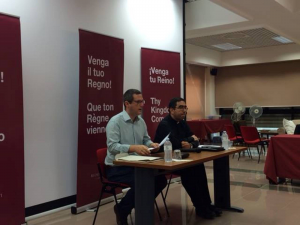 It’s 11 pm here in Rome and I’m back in my room after a feast day Mass and dinner with the LC community at the Center for Higher Studies. It’s always a treat to go there because you run into priests and brothers you know from back home.
It’s 11 pm here in Rome and I’m back in my room after a feast day Mass and dinner with the LC community at the Center for Higher Studies. It’s always a treat to go there because you run into priests and brothers you know from back home.
Though they didn’t stay for dinner, I had a short visit with some consecrated women who are in town either taking or giving a month-long course for those preparing for their final vows. It was a joy to give a big hug to Amelia Hoover. And you old-timers like me can feel jealous: I caught a glimpse of Jacinta Curran and said a quick hello to Patricia Bannon as well. What shall I tell you about our work today?
The picture shows you Salvatore Bonventre and Fr. Rodrigo Ramirez presenting a history of the relationship between the Legion and Regnum Christi from the point of view of all the documents in the Legion’s historical archive. We wanted to educate ourselves on how our movement’s self-conception has changed over time. The subject matter is a little bit tricky for the obvious reason that an important purpose of the renewal is purifying our understanding of our charism and leaving aside the negative legacy of the founder (while not denying the fact that he is the founder). The presentation concentrated on official documents for that very reason — to de-emphasize the person, and pay special attention to official interactions with the Church — especially various iterations of the Legion’s constitutions. (It turns out that at the canonical establishment and Decretum Laudis stages of the approval of a congregation, provisional statutes are submitted and have to receive provisional approval from the Holy See. Therefore, we have several versions of constitutions that were approved at least provisionally from which to make comparisons and notice continuities over time). This topic is probably a bit too complicated to deal with in a quick Facebook post. Suffice it to say the presentation was enlightening –in some ways encouraging and in some ways maddening — but instructive and helpful, and it led to a fascinating and candid conversation afterwards. I expect the document on this history we received in Italian will be translated and published soon.
In the afternoon we broke into groups by branch to discuss a document about the premises of the eventual general statutes to be drafted — we have to agree on what will be covered and what the rules are before we can make any other decisions. This was actually more interesting than it sounds — not least because three of us five lay delegates have some actual expertise in statutory matters. Francisco Gamez of Venezuela is a lawyer. Carmen Fernandez from Spain teaches administrative law and Stefano di Pasquale from here in Rome works for the Pontifical Council on the Laity and knows all about the configurations of lay movements and the typical governance questions. And Jose Antonio Lebrija from Mexico and I made our contributions as well. It’s a good team.

I would be delighted to read the historical document the group used. Need English though.
Good source for the lay renewal process: http://www.regnumchristi.org/comissione/introduction/